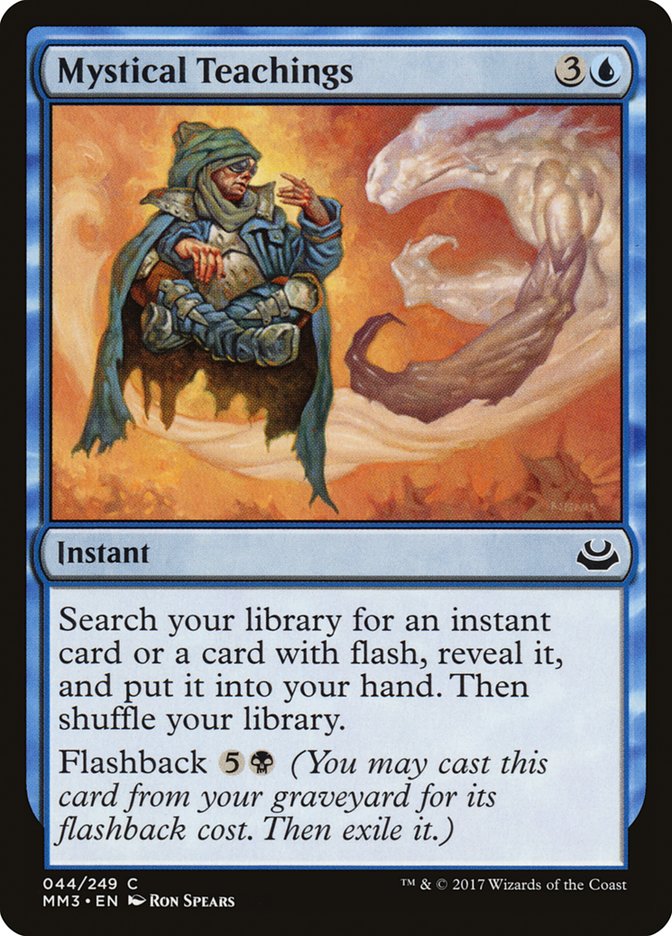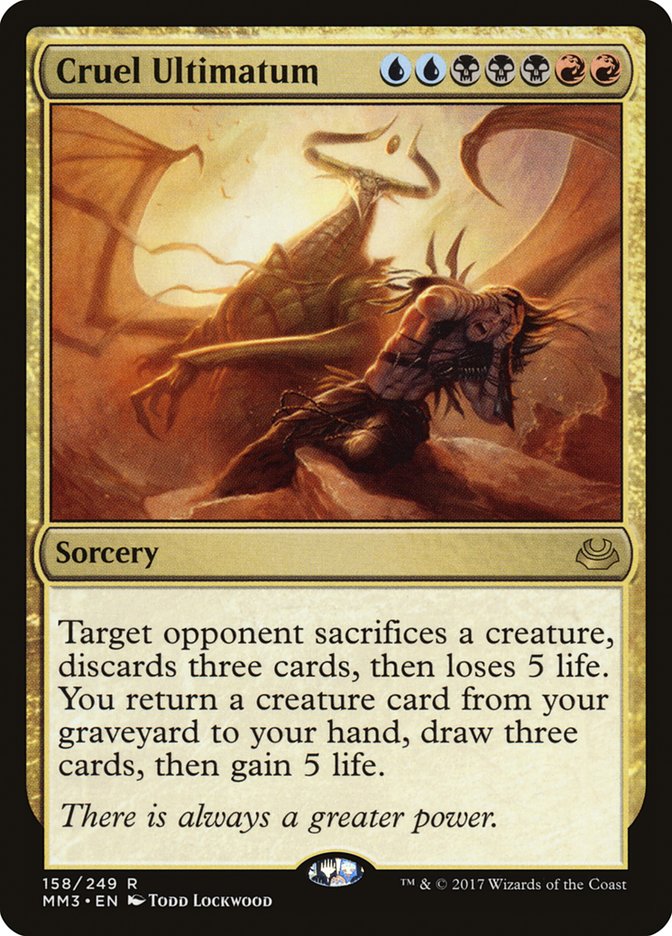In order to be successful in Modern Masters 2017 Limited, It’s paramount to understand the difference between normal Limited and Masters Limited: hyper-linear synergy (usually within a specific archetype). Sure, in Aether Revolt you can draft an “improvise deck,” but the best version of this deck is just some normal midrange strategy with four to six improvise cards and some cheap enablers like Aether Swooper and Implement of Combustion. In no way would I call improvise “hyper-linear,” although it certainly is synergistic.
So how come these so-called Masters Limited environments enable such decks? Well, they are filled with powerful, yet narrow, cards. Sweatworks Brawler and Bastion Inventor can go in any deck and be just fine. But I highly doubt most decks in this format can include Intangible Virtue or Mystical Teachings. If you end up in the right lane, you will get twelfth-pick playables on a relatively consistent basis, and this really rewards proper drafting and reading signals. This is what allows the extreme synergies of these environments and is the reason I love drafting them.
Today I’m going to choose cards for control decks that I think are quite difficult to evaluate for complexity reasons. Don’t take what I say as gospel, and feel free to argue in the comments. With that in mind, let’s take a look at some cards!
This is the kind of card that, on the surface, looks completely abysmal. Tempo is such a huge factor to many Limited games that tutor effects lose a lot of value. We have all put Diabolic Tutor in our decks when we have something like Demon of Dark Schemes, since cards like that make up for the tempo loss, but Mystical Teachings can’t get anything of that caliber unless you count Sphinx’s Revelation or Cyclonic Rift, which I don’t. But this card does a lot more than Diabolic Tutor, so let’s not dismiss it just yet.
Magic R&D has stated that the U/B archetype is instant-speed control. There are around 50 instants or cards with flash in the set, most of which are common or uncommon. Of these, there are really only a few that I would never include in my Mystical Teachings deck, such as Might of Old Krosa and Dynacharge.
I think the key to this archetype is prioritizing cards such that you can choose a good window for casting Mystical Teachings and flashing it back. Grisly Spectacle gives you the option of Murder if necessary, but if not, you get some value out of Mystical Teachings instead. Another card that does this is Rewind, a card most other players won’t want. Since you get to counter their turn 4 play and cast Mystical Teachings, there is no loss of tempo!
Even if this deck is good, I still want to pick up Mystical Teachings late (could be wrong about this one, but I’m quite confident). As I mentioned, only one person at the table is going to want this. I expect to be able to draft other styles of blue control decks in this format, so if I end up that route and get a tenth-pick Mystical Teachings in Pack 1, I know this lane is open, and I can draft “the deck.” And believe you me, I want to draft it!
Note: this deck is going to require splashing in order to play as many powerful instants as possible and will also be very mana-hungry. Signets will be extremely important because they help with both of those requirements. I know Signets will already be high picks, and that just makes them all the more important for this archetype.
Now that we’ve covered a potential core to the U/B archetype, let’s look at Soul Ransom. This might be the most controversial card in the set regarding exactly how good it is. There has been some disagreement on the LR subreddit recently, and there certainly was during Gatecrash. I have heard some people expect the card is a bomb, while others believe it to be unplayable. It’s important to remember our evaluation must be for the current set, and not the last set Soul Ransom was in.
Control Magic is a notorious card in the history of the game. But Soul Ransom is no Control Magic. Soul Ransom is a Control Magic if the creature taken is worth less (to your opponent) than the alternative of discarding two cards and allowing you to draw two. Punisher effects — those which give your opponents the option — are almost always bad, but this is one of the most powerful ones that have ever been printed since both options, individually, are completely backbreaking. The problem is, letting your opponent choose how their back breaks tends to reduce the pain. By a lot.
Since both options are still good, I don’t want to dismiss the card. In fact, in most Limited sets where games aren’t as blisteringly fast as Gatecrash, this card would probably be good. And although there are decks of varying speeds in Modern Masters 2017, I don’t think this card is going to be very good. Let’s look at it in terms of archetypes.
You have W/G and R/G, which seem to be aggressive, go-wide strategies where Soul Ransom is a terrible card. B/R is also an aggressive deck that may very well not care about discarding cards due to the unearth mechanic. And then I expect most of the other decks to have a variety of card advantage and cards with Flashback, which also diminish the power of one of the options bestowed upon your opponent. I am going to play with the card early on to feel it out, but I am expecting it to end up in the sideboard more often than not.
Note: A large downside of this card comes within combat. If you’re not attacking with the creature, the card really doesn’t do much. You see, if you don’t attack, your opponent can activate the ability to get the card back mid-combat, which makes combat difficult. Additionally, leaving it back to block doesn’t work so well since it’s easily removed. So just remember how much better the card is when you’re turning the corner and attacking.
We might as well finish the complex-control-card theme article with one of the most powerful cards ever printed (“powerful” meaning that it’s a ten-for-one, not that it’s good). Cruel Ultimatum is an absurd Magic card. If you ever cast it without being substantially behind — as in “so behind that five life and a Diabolic Edict don’t help you not die next turn” — you’re probably going to win the game. But let’s set something straight first: this card is not remotely splashable, so you must be hard in Grixis.
But even great mana is barely enough for this card. With nine red, eleven black, and nine blue sources, you only have a 53% chance of casting this card by turn 10 on the play. So you can see why I’m hesitant to recommend drafting the card. This doesn’t mean it’s bad or impossible to play; I’m just cautious about my initial evaluation before a complete comprehension of the speed of the set.
Here’s the thing: as much as I tell you not to take this card, you’re going to take it. It’s one of the sweetest cards of all time, and you’ll rarely get a chance to draft a deck that can utilize it ever again. Because of that, here’s what I’m going to do: assume it’s good. Assume that you can do the thing, and tell you how to reduce the probability that you lose to the fact that you’re trying to play this nigh-impossible-to-cast bomb. Here are a couple of good heuristics:
1. Take
2. Play eighteen, or even nineteen, lands (and prioritize fixing, but this is obvious).
3. Prioritize efficient card draw such as Compulsive Research.
All of these take significant strides towards reducing the probability you end up in a game where you never have the ability to cast Cruel Ultimatum. The third point is significantly more important than you realize. Drawing an additional three cards, aka just casting Compulsive Research once, increases the probability you can cast Cruel Ultimatum on turn 10 by about 30%! So if you decide to follow your sweet tooth down this route, remember, card draw and Signets skyrocket in value.




